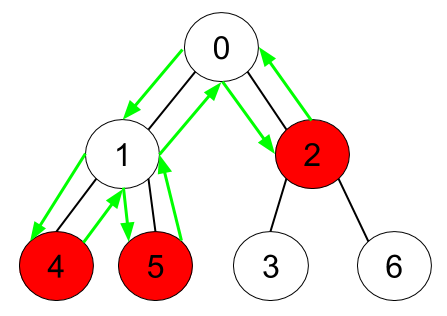1443 - Minimum Time to Collect All Apples in a Tree (Medium)
Problem Link
https://leetcode.com/problems/minimum-time-to-collect-all-apples-in-a-tree/
Problem Statement
Given an undirected tree consisting of n vertices numbered from 0 to n-1, which has some apples in their vertices. You spend 1 second to walk over one edge of the tree. Return the minimum time in seconds you have to spend to collect all apples in the tree, starting at vertex 0 and coming back to this vertex.
The edges of the undirected tree are given in the array edges, where edges[i] = [ai, bi] means that exists an edge connecting the vertices ai and bi. Additionally, there is a boolean array hasApple, where hasApple[i] = true means that vertex i has an apple; otherwise, it does not have any apple.
Example 1:

Input: n = 7, edges = [[0,1],[0,2],[1,4],[1,5],[2,3],[2,6]], hasApple = [false,false,true,false,true,true,false]
Output: 8
Explanation: The figure above represents the given tree where red vertices have an apple. One optimal path to collect all apples is shown by the green arrows.
Example 2:

Input: n = 7, edges = [[0,1],[0,2],[1,4],[1,5],[2,3],[2,6]], hasApple = [false,false,true,false,false,true,false]
Output: 6
Explanation: The figure above represents the given tree where red vertices have an apple. One optimal path to collect all apples is shown by the green arrows.
Example 3:
Input: n = 7, edges = [[0,1],[0,2],[1,4],[1,5],[2,3],[2,6]], hasApple = [false,false,false,false,false,false,false]
Output: 0
Constraints:
1 <= n <= 1e5edges.length == n - 1edges[i].length == 20 <= ai < bi <= n - 1fromi < toihasApple.length == n
Approach 1: DFS + Backtracking
- Let's make another array out of
edgesand call itgraph, where each elementgraph[i]contains neighbour edges. - Perform DFS + backtracking to calculate the minimum time in second using
graph.
Time Complexity:
Space Complexity:
- Python
- Go
- C++
class Solution:
def minTime(self, n: int, edges: List[List[int]], hasApple: List[bool]) -> int:
# Edge case: no apples - just return 0
if len(list(filter(lambda edge: edge, hasApple))) == 0:
return 0
# Create a graph using edges
graph: List[List[int]] = [[] for _ in range(n)]
for edge_a, edge_b in edges:
if edge_b not in graph[edge_a]:
graph[edge_a].append(edge_b)
if edge_a not in graph[edge_b]:
graph[edge_b].append(edge_a)
def dfs(current: int, parent: int) -> int:
sub_total = 0
for child in graph[current]:
# If child == parent, do nothing to prevent going back to the parent
# If not, this should be an index of a child edge
# -> perform dfs and add the result to sub total
if child != parent:
sub_total += dfs(child, current)
# If the edge has apples in it, or if children has apples,
# we need to visit it -> add extra 2
if hasApple[current] or 0 < sub_total:
return sub_total + 2
# Else, this edge has no apples, or no children that have apples.
# So we don't have to visit this edge -> just return 0
return 0
# In this approach dfs() assumes there is always a parent edge connected to it.
# But since root doesn't have it - the result has 2 extra unit of seconds.
# Therefore subtract 2 from the result of dfs()
return dfs(0, -1) - 2
func minTime(n int, edges [][]int, hasApple []bool) int {
// Edge case: no nodes containing apple
flag := false
for _, apple := range hasApple {
flag = flag || apple
}
if !flag {
return 0
}
// Create a graph
graph := make([][]int, n)
for _, edgeIndexes := range edges {
edgeA := edgeIndexes[0]
edgeB := edgeIndexes[1]
if !contains(graph[edgeA], edgeB) {
graph[edgeA] = append(graph[edgeA], edgeB)
}
if !contains(graph[edgeB], edgeA) {
graph[edgeB] = append(graph[edgeB], edgeA)
}
}
var dfs func(current, parent int) int
dfs = func(current, parent int) int {
subTotal := 0
for _, child := range graph[current] {
if child != parent {
// child index points to a child edge
subTotal += dfs(child, current)
}
}
if hasApple[current] || 0 < subTotal {
return subTotal + 2
}
return 0
}
return dfs(0, -1) - 2
}
func contains(edges []int, target int) bool {
for edge := range edges {
if edge == target {
return true
}
}
return false
}
class Solution {
public:
int minTime(int n, vector<vector<int>>& edges, vector<bool>& hasApple) {
vector<vector<int>> g(n);
for (auto x : edges) {
g[x[0]].push_back(x[1]);
g[x[1]].push_back(x[0]);
}
// u = currenct vertex
// p = parent vertex
function<int(int, int)> dfs = [&] (int u, int p) {
int res = 0, t = 0;
for (auto v : g[u]) {
// if v is not same as p
if (p ^ v) {
// calculate the child time
t = dfs(v, u);
// if there is an apple in the subtree, we need 2 seconds to collect it and head back
// if we are in vertex 1, we need 4 seconds to collect all the apples in 4 & 5
// i.e. (1 -> 4, 4 -> 1, 1 -> 5, 5 -> 1)
// how does 0 know that 1 has collected the apple? check the time, i.e. `t`
// if t > 0, it means we got some apples in sub trees
if (t > 0 || hasApple[v]) {
res += t + 2;
}
}
}
return res;
};
return dfs(0, -1);
}
};